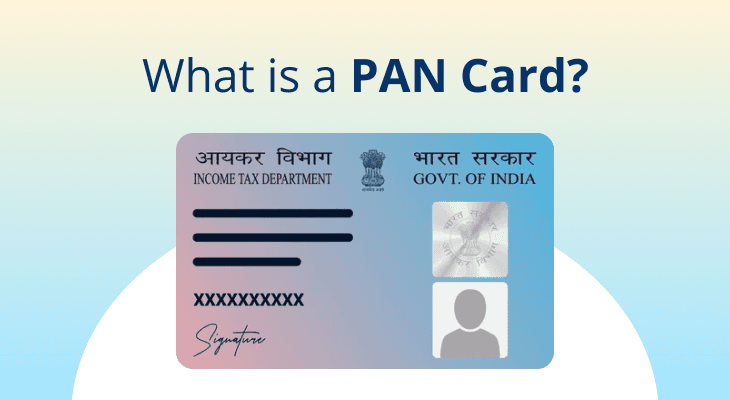
What Is A PAN Card?
Introduction
Identification documents play a crucial role in a person’s life. The Permanent Account Number (PAN) Card is one such identification document. However, it is more than just a proof of identity. It is a vital tool for various financial purposes. Let’s explore why the PAN Card is so significant.
What Is A PAN Card?
A PAN Card is an identification document for all taxpayers in India. It is issued by the Income Tax Department. The PAN Card carries a unique 10-digit alphanumeric number that helps track all your tax-related information. PAN Cards can be issued to individuals as well as entities.
Why Is A PAN Card Important?
Here’s why a PAN Card is important:
- It contains key personal information about an individual or entity.
- It serves as a central record of all your tax-related details.
- It is linked to your investments and makes it easier to track financial transactions.
- It is mandatory for several banking tasks.
- It is necessary for several high-value transactions.
- It is essential for registering a business.
Key Features Of A PAN Card
Here are some features of a Pan Card:
- 10-digit alphanumeric code: Every PAN Card contains a unique 10-character alphanumeric number. The first three characters are alphabets, while the fourth character indicates the type of taxpayer. The fifth character represents the taxpayer’s surname for individuals or name for entities. The remaining four digits and the last alphabet are generated arbitrarily to ensure uniqueness.
- Unique fourth character for each tax category: The fourth letter on a PAN card holds special significance, as it represents the taxpayer's category. Here’s how this works
- A is used for Association of Persons (AoP)
- B is used for Body of Individuals (BoI)
- C is used for Company
- F is used for Firm
- G is used for Government
- H is used for Hindu Undivided Family (HUF)
- L is used for Local Authority
- J is used for Artificial Juridical Person
- P is used for Individual
- T is used for Association of Persons for a Trust
- Unique identification: Each PAN Card is unique to a person or entity. No two individuals or organisations can share the same number.
- Types of PAN Cards: There are different types of PAN Cards issued to a range of taxpayers, including minors, adults, companies, HUFs, Limited Liability Partnerships (LLPs), trusts, societies, BOIs, AOPs, and even foreign nationals with taxable income in India.
What Is The Use Of A PAN Card In India?
Here are some uses of a PAN Card in India:
Buying And Selling Assets
- Sale or purchase of a vehicle except two-wheelers
- Sale or purchase of stocks of an unlisted company exceeding ₹1 lakh per transaction
- Sale or purchase of immovable property exceeding ₹10 lakh
- Sale or purchase of goods or services exceeding ₹2 lakh per transaction
Banking And Financial Transactions
- Opening a bank account
- Opening a current or cash credit account in a bank or post office
- Depositing cash of ₹20 lakh or more in aggregate in a financial year
- Withdrawing cash of ₹20 lakh or more in aggregate in a financial year
- Depositing cash exceeding ₹50,000 in a single day with a bank or co-operative bank
- Making time deposits exceeding ₹50,000 or ₹5 lakh in aggregate in a financial year with banks, post office, Non-Banking Financial Companies (NBFCs), or Nidhis
Payments And Purchases
- Payment exceeding ₹50,000 for buying jewellery or other specified goods
- Payment of life insurance premiums exceeding ₹50,000 in a financial year
- Payment in cash exceeding ₹50,000 to a hotel or restaurant in a single bill
- Payment exceeding ₹50,000 for foreign travel or purchase of foreign currency
- Payment exceeding ₹50,000 to mutual funds, companies, or the Reserve Bank of India (RBI) for purchase of units, debentures, or bonds
- Payment exceeding ₹1 lakh for the sale or purchase of securities other than shares
- Payment in cash for the purchase of pay orders, bank drafts, or banker’s cheques exceeding ₹50,000 in a single day
Investment and Market Transactions
- Opening a demat account
- Applying for a credit card or debit card
Who Needs A PAN Card?
A PAN Card is required by a wide range of individuals and entities in India. Here’s who typically needs to apply for one:
- All individual taxpayers whose income exceeds the basic exemption limit, and those who need to file income tax returns or conduct high-value financial transactions
- Professionals or business owners earning an annual income of ₹5lakh or more
- HUFs that have taxable income
- Companies registered under the Companies Act
- Trusts and societies that are eligible to pay tax
- Non-Resident Indians (NRIs) who earn income taxable in India
- Foreign nationals who intend to conduct financial transactions in India
- Entities involved in the export or import of goods and services
How To Apply For A PAN Card?
There are different ways to apply for a PAN Card. Here’s how each of these works:
Online On The National Securities Depository Limited (NSDL) Portal
- Visit the NSDL website and select the appropriate PAN Card application type and category, then fill in your personal details and click ‘Submit’.
- Upload the required documents, pay the processing fee, and save the acknowledgement number.
- The PAN Card is normally dispatched within 15 to 20 days after you submit the application.
Online On The UTI Infrastructure Technology And Services Limited (UTIITSL) portal
- Visit the UTIITSL portal, select the appropriate application type and category, then fill in your personal details and click ‘Submit’.
- Choose the document submission mode, applicant status, and PAN Card format before submitting.
- Complete the online form with your details, upload the required documents, and proceed to payment.
- The PAN Card is normally dispatched within 15 to 20 days after you submit the application.
Offline
- Download and print Form 49A (for Indian citizens) or Form 49AA (for foreign citizens), or obtain the form from a PAN centre.
- Fill in your details, affix a recent colour photograph, sign the form, and attach the required documents.
- Visit your nearest PAN centre, submit the PAN Card application along with the documents, and pay the fees.
Conclusion
A PAN Card is an essential financial document. If you have not applied for one yet, do so at the earliest to avoid any inconvenience later. Once you receive your PAN card, keep it safe and accessible so that you can produce it whenever needed.
FAQ
Can I apply for a PAN Card online?
Yes, you can apply online through the NSDL or UTIITSL portals.
How can I check the status of my PAN Card application?
You can track the status on the official websites of NSDL and UTIITSL. Simply enter your acknowledgement number or application number. The current status of your application will be displayed on the screen.
What is the difference between Form 49A and Form 49AA for PAN application?
Form 49A is meant for Indian citizens, while Form 49AA is for foreign citizens.
Is a PAN Card mandatory for students or unemployed individuals?
A PAN Card is not mandatory for students or unemployed individuals unless they need to file income tax returns and their income exceeds the basic exemption limit. However, it is required if they carry out high-value financial transactions.
Is it necessary to link PAN with Aadhaar?
Yes, linking PAN with Aadhaar is mandatory as per government regulations.


